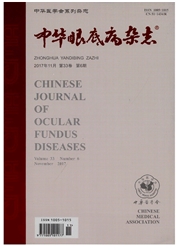

 中文摘要:
中文摘要:
目的观察未折叠蛋白反应(UPR)标志物葡萄糖调节蛋白78(GRP78)在大鼠实验性视网膜脱离(RD)后不同时期的基因与蛋白水平的表达情况,探讨UPR与RD后细胞损伤的关系。方法88只Wistar大鼠分为2组:正常对照组11只鼠;RD组77只鼠,左眼视网膜下注射10mg/ml透明质酸钠建立RD模型,分别在RD后1/2、1、2、4、8、16、32d收集大鼠左眼球及视网膜组织,RD后各时间组每组各11只大鼠。用半定量逆转录-聚合酶链反应(RT-PCR)方法检测视网膜组织中GRP78mRNA的表达;Western cblotting方法检测视网膜组织中GRP78蛋白水平的表达;免疫荧光及激光共聚焦显微镜技术观察GRP78在视网膜各层细胞的分布。结果建立大鼠RD模型后,1/2、1、2、4d组大鼠视网膜GRP78mRNA表达显著升高(P〈0.05);RD后各组大鼠视网膜GRP78蛋白水平均高于正常对照组(P〈0.05),8、16、32d组大鼠GRP78蛋白水平为高峰;GRP78蛋白在RD大鼠视网膜全层细胞均有表达。结论实验性RD后,启动UPR保护机制,通过上调分子伴侣GRP78的表达,引导蛋白质正确折叠,降低细胞损伤;这为通过干预该反应降低RD患者的细胞损伤,促进视功能恢复提供了理论依据。
 英文摘要:
英文摘要:
Objective To observe the expression of gene and protein level of unfolded protein, glucose-regulated protein 78 (GRP78), after retinal detachment (RD); to find out the relationship between UPR and the cell damage after RD. Methods Eighty-eight Wistar rats were divided into 2 groups : control group (11 rats) and RD group (77 rats). In RD group, subretinal injection with 10 mg/ml hyaluronic acid sodium was performed on the left eyes of the rats to set up RD model, and the left eyes and retinal tissue were collected 1/2 day, 1 day, 2, 4, 8, 16 and 32 days after RD; there were 11 rats in each subgroup. The expression of GRP78 mRNA in retina tissue was detected by semi-quantitative reverse transcription polymerase chain reaction (RT-PCR), the expression of GRP78 protein level was detected by Western blotting, and the distribution of GRP78 in each retinal layer was observed by immunofluorescence labeling method and confocal microscopy. Results The expression of retinal GRP78 mRNA significantly increased in 1/2 day, 1 day, 2, and 4 days subgroups after RD (P~0.05). The expression of GRP78 protein significantly increased in each subgroup after RD compared with which in the control group, and reached the peak in 8, 16, and 32 days subgroups. The expression of GRP78 protein was detected in all of the retinal layers after RD. Conclusion The protection mechanism of UPR starts up after RD, and leads the correct pucker of the protein and reduces cellular injury by up-regulating the expression of GRP78, which provide the theoretic basis for reducing the cellular injury and improving the visual function in patients with RD.
 同期刊论文项目
同期刊论文项目
 同项目期刊论文
同项目期刊论文
 期刊信息
期刊信息
